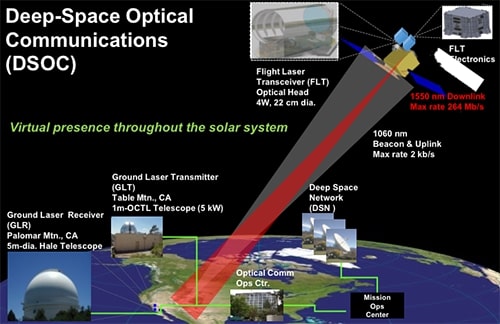Radio frequency based deep space communication faces constraints due to low bandwidth and increasing need of high data transmission rates. Laser or optical based system has potential to break the communication constraints. NASA has tested laser communications against extreme distances and demonstrated high-bandwidth communications in deep space when it beamed to Earth an ultra-high-definition video via laser from a distance of 32 million km, from Psyche spacecraft which is currently travelling through deep space to metal-rich asteroid Psyche located in the asteroid belt between Mars and Jupiter. This was first demonstration of optical communications beyond the Moon. Deep Space Network (DSN) antenna received both radio frequency and near-infrared laser signals.
Deep space communication is mostly conducted using radio frequencies. However, radio frequency-based system cannot meet current and future communication needs of space sector in view of limited bandwidth and ever-increasing demand of high data transmission rates.
On the other hand, laser or optical based communication offer many advantages in terms of large bandwidths, high data rate links and low SWaP (size, weight and power) terminals. It has the potential to enhance data rates 10 to 100 times the capacity of most sophisticated radio systems currently in use thus can break the communication constraints. Hence, the imperative to advance optical communications for high-capacity deep space communications capable of meeting future interplanetary data transmission needs.
Deep Space Optical Communications (DSOC) experiment is a technology demonstration payload onboard Psyche spacecraft which is currently travelling through deep space to metal-rich asteroid Psyche located in the asteroid belt between Mars and Jupiter. In December 2023, it demonstrated high-bandwidth communications in deep space when it beamed to Earth an ultra-high-definition video via laser from 32 million km in deep space. This was first demonstration of optical communications beyond the Moon.
The Deep Space Network (DSN) is network of facilities located in different parts of the world to communicate with faraway spacecrafts exploring solar system. An experimental antenna of this network received both radio and laser signals beamed from Psyche spacecraft in deep space. This suggests that DSN antennas which currently communicate with spacecrafts via radio signals could be retrofitted for laser communications.
***
References:
- Karmous S., et al 2022. How Can Optical Communications Shape the Future of Deep Space Communications? A Survey. Preprint arXiv. DOI: https://doi.org/10.48550/arXiv.2212.04933
- Robinson B.S., 2023. Optical Communications for Space Exploration and Science. Optical Fiber Communications Conference 2023.
- NASA’s Tech Demo Streams First Video from Deep Space via Laser. Posted 18 December 2023. Available at https://www.nasa.gov/directorates/stmd/tech-demo-missions-program/deep-space-optical-communications-dsoc/nasas-tech-demo-streams-first-video-from-deep-space-via-laser/
- NASA. News – NASA’s New Experimental Antenna Tracks Deep Space Laser. Posted on 08 February 2024.Avaialble at https://www.nasa.gov/technology/space-comms/deep-space-network/nasas-new-experimental-antenna-tracks-deep-space-laser/
- Deep Space Optical Communications (DSOC) https://www.nasa.gov/mission/deep-space-optical-communications-dsoc/
- Mission Psyche. https://science.nasa.gov/mission/psyche/
- NASA’s Deep Space Network (DSN) https://www.jpl.nasa.gov/missions/dsn
***






































